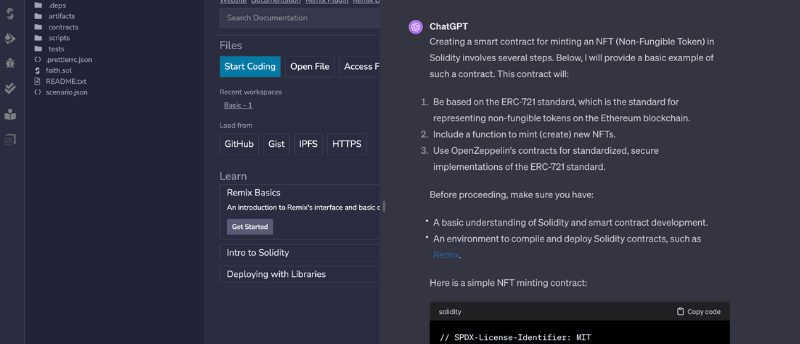7 Easy Prompts To Debug Solidity With ChatGPT
Use these 7 amazing prompts to blast past any blocks in Solidity and don't forget to use an IDE like Remix to test in real time.
NFTmansa
12/8/20232 min read


7 Easy Prompts To Debug Solidity With ChatGPT
Introduction to Debugging in Solidity
Debugging in Solidity, the programming language used for Ethereum smart contracts, is a critical skill for blockchain developers. Unlike traditional software, bugs in smart contracts can have severe financial and security implications. Solidity's unique environment, interacting with the Ethereum Virtual Machine (EVM), presents distinct challenges in identifying and rectifying errors.
Basic Debugging Practices in Solidity
Before leveraging advanced tools, it's essential to grasp the basics of Solidity debugging. This includes understanding common error messages, the nuances of smart contract execution, and the use of Solidity's native debugging tools. Familiarizing yourself with the Solidity environment and its peculiarities, like gas computation and transaction reversibility, is crucial.
Advanced Solidity Debugging Techniques
For more intricate issues, advanced techniques are necessary. These might include using testing frameworks like Truffle or Hardhat, employing static analysis tools to preemptively spot vulnerabilities, and understanding how to interact with the blockchain for live debugging. Advanced practices also involve thorough testing, including unit and integration tests to ensure contract reliability.
Seven Prompts for Debugging Solidity with ChatGPT
Understanding Contract Errors: "I have this error in my Solidity smart contract [insert error]. What does it mean, and how can I fix it?"
Optimizing Gas Usage: "This Solidity function seems to use too much gas. Can you suggest optimizations?"
Security Vulnerability Identification: "Can you review my Solidity contract [insert code] for potential security risks?"
Compliance with ERC Standards: "Does my contract [insert code] adhere to the ERC-721 standard for NFTs? What changes are needed?"
Smart Contract Logic Verification: "I’m not sure if my contract’s logic works as intended. Can you help verify it?"
Deciphering Transaction Failures: "Why did this transaction fail on my Solidity contract [provide transaction details]?"
Code Review for Best Practices: "Please review my Solidity code [insert code] for adherence to best practices and potential improvements."
Conclusion
Debugging in Solidity is a nuanced and crucial skill in the realm of blockchain development. With these prompts, you can leverage ChatGPT's capabilities to tackle a broad spectrum of debugging challenges, from simple syntax errors to complex logic verification. Remember, effective debugging in Solidity not only improves your code but also enhances the security and efficiency of the blockchain ecosystem.
More Resources:
Contacts
info@hackgptbook.com
Socials
Join the HackGPT Newsletter to stay updated!
Links
Terms & Conditions
